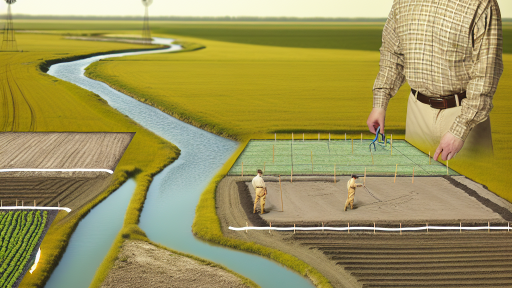Introduction to No-Till Farming
No-till farming is a revolutionary agricultural practice.
This method involves growing crops without disturbing the soil.
It contrasts with traditional tillage, which involves plowing the soil.
Farmers implement no-till strategies to enhance soil health.
This practice is gaining popularity worldwide due to its benefits.
Definition of No-Till Farming
No-till farming refers to planting crops directly into undisturbed soil.
Farmers usually utilize special equipment to achieve this.
These tools help plant seeds safely while preserving soil structure.
Consequently, this method fosters healthier ecosystems in fields.
Overview of No-Till Farming Methodologies
Various techniques exist within the no-till farming approach.
Cover cropping is a popular method used by many farmers.
This involves planting specific crops to cover the soil.
Another technique is mulch planting, which protects soil moisture.
Farmers may also use crop rotation to enhance soil nutrients.
Reasons for Adopting No-Till Practices
Farmers adopt no-till practices for several compelling reasons.
Transform Your Agribusiness
Unlock your farm's potential with expert advice tailored to your needs. Get actionable steps that drive real results.
Get StartedPrimarily, it improves soil health and fertility over time.
This technique helps retain moisture, reducing irrigation needs.
Moreover, it minimizes soil erosion caused by wind or rain.
Additionally, no-till farming lowers fuel and labor costs.
Benefits of No-Till Farming for Soil Health and Structure
Improved Soil Structure
No-till farming enhances soil structure significantly.
This method reduces soil compaction and improves porosity.
As a result, roots can grow deeper and access nutrients more effectively.
Moreover, better soil structure helps retain moisture.
Increased Organic Matter
No-till practices promote the accumulation of organic matter.
Crop residues remain on the surface and decompose slowly.
This process enriches the soil and supports microbial activity.
Consequently, increased organic matter improves soil fertility.
Enhanced Water Retention
No-till farming significantly improves water retention in the soil.
Soil aggregates hold water better when not disturbed.
This enhances drought resilience for crops.
Additionally, it reduces the need for irrigation.
Reduced Erosion
No-till farming effectively reduces soil erosion.
This method preserves topsoil through crop cover.
As a result, there is less runoff and better water infiltration.
Furthermore, reduced erosion enhances the land’s productivity.
Promotion of Biodiversity
No-till practices foster increased biodiversity in the soil.
A diverse soil ecosystem improves resilience to pests and diseases.
Moreover, it contributes to balanced nutrient cycling.
This overall biodiversity leads to healthier crops.
Showcase Your Farming Business
Publish your professional farming services profile on our blog for a one-time fee of $200 and reach a dedicated audience of farmers and agribusiness owners.
Publish Your ProfileEnvironmental Benefits
No-till farming contributes to environmental sustainability.
This practice decreases carbon emissions from soil disturbance.
It also lowers fuel consumption due to fewer tillage operations.
Thus, no-till farming presents a practical solution for reducing agriculture’s carbon footprint.
Comparison of No-Till Farming vs. Conventional Tillage Practices
Understanding Tillage Practices
Conventional tillage involves the frequent turning of soil.
This process can disrupt soil structure significantly.
No-till farming leaves the soil undisturbed.
Therefore, it helps maintain a stable soil ecosystem.
Additionally, no-till minimizes erosion risks.
In contrast, conventional tillage can lead to increased runoff.
Overall, tillage methods influence soil health in distinct ways.
Soyl Health and Fertility
No-till practices enhance soil health over time.
This occurs due to the retention of organic matter.
Conventional tillage often depletes this crucial component.
In addition, no-till fosters beneficial organisms in the soil.
These organisms play key roles in nutrient cycling.
Consequently, no-till can improve soil fertility sustainably.
Conversely, conventional methods may require more fertilizers.
Water Retention and Irrigation
No-till farming increases soil’s ability to retain moisture.
This leads to reduced irrigation needs in dry seasons.
Moreover, the soil structure remains intact, aiding water absorption.
On the other hand, conventional tillage can create a crust.
This crust prevents water from soaking into the soil effectively.
As a result, farmers may face higher irrigation costs.
Carbon Sequestration
No-till farming supports carbon sequestration initiatives.
This process helps mitigate climate change effects.
By keeping soil covered, no-till minimizes carbon loss.
In contrast, conventional tillage releases stored carbon into the atmosphere.
Thus, no-till practices can serve environmental sustainability goals.
Furthermore, they contribute to a healthier atmosphere.
Economic Considerations
No-till farming may lower long-term production costs.
This occurs due to reduced fuel and labor costs.
Conversely, conventional tillage can be labor-intensive.
This approach often leads to higher operational expenses.
Additionally, farmers may benefit from improved soil health.
Ultimately, no-till presents a financially viable option.
Learn More: Soil Microbes And Their Role In Regeneration
The Role of Organic Matter in Soil Regeneration through No-Till
Importance of Organic Matter
Organic matter serves as the foundation of healthy soil.
It enhances soil structure, allowing better water retention.
This retention aids in promoting beneficial microbial activity.
Showcase Your Farming Business
Publish your professional farming services profile on our blog for a one-time fee of $200 and reach a dedicated audience of farmers and agribusiness owners.
Publish Your ProfileAs a result, organic matter supports overall soil health.
Enhancing Soil Fertility
Integrating organic matter boosts soil fertility significantly.
It provides essential nutrients to plants over time.
Furthermore, it helps in preventing nutrient leaching.
This retention ensures crops receive adequate nourishment.
Reducing Soil Erosion
Healthy levels of organic matter combat soil erosion effectively.
It binds soil particles together, forming a robust structure.
Consequently, this structure reduces the risk of runoff.
Moreover, it mitigates the impact of heavy rainfall.
Promoting Biodiversity
Organic matter contributes to increased soil biodiversity.
It creates a favorable habitat for various organisms.
These organisms, in turn, improve soil function.
They aid in nutrient cycling and organic decomposition.
Incorporating Organic Matter in No-Till Systems
No-till farming practices facilitate organic matter buildup.
Cover crops are an excellent way to add organic matter.
Additionally, compost and mulch can enhance soil organic content.
These practices combine to foster a resilient soil ecosystem.
Discover More: Maximizing Soil Health with Effective Crop Rotation
Implementing No-Till Farming: Techniques and Strategies
Understanding No-Till Techniques
No-till farming minimizes soil disturbance.
This technique preserves soil structure and moisture.
Farmers can apply various no-till methods.
Each method caters to specific crops and soil types.
Cover Cropping
Cover crops protect the soil between growing seasons.
They reduce erosion and enhance organic matter.
Additionally, cover crops improve nutrient cycling.
Common cover crops include clover, rye, and vetch.
Crop Rotation
Crop rotation disrupts pest and disease cycles.
This strategy enhances soil fertility over time.
Diverse crops support a healthier soil biome.
Farmers should plan rotations carefully for maximum benefits.
Using Mulch
Mulch provides numerous benefits to no-till systems.
It helps retain moisture and suppress weeds.
Organic mulch decomposes, adding nutrients to the soil.
Farmers can utilize straw, wood chips, or grass clippings.
Precision Equipment
Modern technology plays a vital role in no-till farming.
Precision planters ensure accurate seed placement.
Such equipment minimizes disturbance during planting.
Farmers should consider investing in high-quality tools.
Monitoring Soil Health
Regular soil testing is crucial for no-till success.
Analyzing soil composition improves management practices.
Showcase Your Farming Business
Publish your professional farming services profile on our blog for a one-time fee of $200 and reach a dedicated audience of farmers and agribusiness owners.
Publish Your ProfileFarmers can stay informed about nutrient needs.
Maintaining optimal pH levels is also essential.
Community Education and Support
Farmers benefit from local agricultural programs.
Workshops can provide no-till education and resources.
Networking with other farmers fosters shared knowledge.
Farmers can explore cooperative purchasing of equipment.
Uncover the Details: Integrating Renewable Energy Into Farm Planning Designs

Impact of No-Till Farming on Water Conservation and Erosion Control
Water Conservation Benefits
No-till farming significantly improves water conservation.
This method allows more rainwater to infiltrate the soil.
As a result, it reduces runoff and increases groundwater recharge.
The crops benefit from greater water availability during dry periods.
Farmers like Emily Carter report improved yields due to enhanced water retention.
Moreover, no-till practices maintain moisture levels effectively.
Consequently, plants can thrive even in challenging weather conditions.
Farmers appreciate these benefits as they reduce irrigation costs.
Erosion Control Advantages
No-till farming is highly effective in controlling soil erosion.
It minimizes soil disturbance, preserving organic matter.
This method maintains the soil structure essential for crop growth.
Additionally, protective crop residues shield the soil surface.
Farmers witness a noticeable stabilization of soil over time.
In fact, studies show up to 90% reduction in erosion rates.
Communities benefit from less sediment in local waterways.
This practice plays a crucial role in protecting ecosystem health.
Long-Term Sustainability
No-till farming promotes long-term agricultural sustainability.
Farmers can maintain healthier soils with reduced chemical inputs.
This strategy enhances soil conservation, allowing for diverse cropping systems.
Additionally, it leads to better carbon sequestration in the soil.
Sustainability advocates, like Peter Lewis, endorse this method.
They assert it is vital for addressing climate change impacts.
Consequently, no-till farming can support more resilient farming systems.
Overall, it contributes positively to both environmental and economic stability.
Learn More: Water Conservation Strategies In Sustainable Farm Design
Challenges and Common Misconceptions about No-Till Farming
Understanding the Basic Concept
No-till farming involves leaving the soil undisturbed.
This practice helps preserve soil structure and health.
Unfortunately, it is often misunderstood by traditional farmers.
Common Misconceptions
Many believe no-till farming reduces crop yields.
In reality, it can enhance yield by improving soil fertility.
Another misconception is that it requires more herbicides.
However, effective management can minimize chemical use.
Resistance to Change
Some farmers resist no-till methods due to tradition.
Showcase Your Farming Business
Publish your professional farming services profile on our blog for a one-time fee of $200 and reach a dedicated audience of farmers and agribusiness owners.
Publish Your ProfileThey fear losing control over soil erosion and weed management.
However, modern techniques address these concerns efficiently.
Education and training can help alleviate these fears.
Environmental Considerations
A common worry is the potential for increased weed growth.
But, no-till farming often promotes natural weed suppression.
This can lead to a healthier ecosystem over time.
Technical Challenges
Implementing no-till methods requires specialized equipment.
Farmers may face high initial costs for these tools.
Yet, many find that long-term savings outweigh the costs.
Impact on Soil Health
Some skeptics doubt the benefits to soil health.
Research shows that no-till practices can boost soil biodiversity.
This enhances nutrient cycling and improves crop resilience.
Long-Term Benefits
Farmers might struggle with immediate results from no-till.
However, the long-term benefits often outweigh short-term challenges.
Improved soil health leads to better water retention and reduced runoff.
Case Studies: Successful No-Till Farming Practices Around the World
Innovations in Brazil
Brazil has pioneered no-till farming techniques on a large scale.
Agricultural engineers like Dr. Carlos Becker have contributed significantly.
The country’s farmers have adopted cover cropping extensively.
This practice enhances soil structure and reduces erosion.
Moreover, crop rotation helps maintain soil fertility over time.
The results show increased yields and reduced agricultural input costs.
Progress in the United States
No-till farming has gained substantial traction in the Midwest.
Farmers like Amy Johnson have embraced this sustainable method.
The implementation of advanced machinery has made no-till more viable.
Together, they practice cover cropping and integrated pest management.
These strategies have led to improved soil health and reduced need for chemical fertilizers.
Advancements in Australia
Australian farmers have turned to no-till farming to combat drought.
Pioneers include Bob McDonald, who showcases successful practices.
His farm exhibits the benefits of minimal soil disturbance.
Cover crops play a critical role in moisture retention.
As a result, soil organic matter has significantly increased.
Farmers report better resilience during harsh weather conditions.
Successful Implementations in Europe
Countries like Germany and France are making strides in no-till practices.
Farmers utilize precision agriculture technologies effectively.
Innovators such as Klaus Müller focus on soil health restoration.
Incorporating legumes into crop rotations has shown promising results.
These methods improve nitrogen fixation and biodiversity in the soil.
Ultimately, they contribute to the sustainability of the agricultural sector.
Impact across Africa
No-till farming is emerging as a transformative technique in Africa.
In Kenya, for instance, farmers see improved yields and soil health.
Showcase Your Farming Business
Publish your professional farming services profile on our blog for a one-time fee of $200 and reach a dedicated audience of farmers and agribusiness owners.
Publish Your ProfileThe efforts of organizations like the Alliance for a Green Revolution promote education.
They provide training on sustainable agriculture practices.
Farmers report reduced soil erosion and enhanced food security.
The results are a testament to the effectiveness of no-till farming.
Additional Resources
Regenerative Agriculture Practices | World Resources Institute




